Updates from Letty – June 6, 2025
Blog posts are the personal views of Letty Hardi and not official statements or records on behalf of the Falls Church City Council
Dear Friends,
Happy summer (and happy last day of school for fellow FCCPS families)! This week’s post will cover 3 topics:
1/ Proposed townhomes on S. Lee – we had an initial work session this week. As with most land use proposals, there is a fair amount of misinformation so I wanted to share the facts and my personal thoughts on pros and cons. Fair warning – it’s lengthy but whether you live in this neighborhood or not, it’s worth reading IMO.
2/ Smart Cities – we won a $10M grant from the state to be a testbed for Smart Cities and the implementation is underway. Some cool tech will be coming to Falls Church and the first thing we’ll experience is smarter, better signal timing on Broad St this fall – which I know is a common point of frustration during rush hour congestion.
3/ New businesses and economic development updates – this is an always popular update and we’ve got a lot of exciting things coming, including the soft opening of Paragon Theaters next Friday, June 13.
With summer schedules, we’re scaling back our City Council meetings from weekly to two per month (Council committees, boards and commissions, office hours continue), so my posts will also scale back. Our next Monday meeting will be June 16, and then we’ll have two meetings in the first half of July and two meetings in the first half of August – we review our schedule in a public meeting weekly, so you can always see what’s coming up. I appreciate the kind emails you’ve shared with me about our salaries from my post last week – I’m happy to continue hearing from you offline and we’ll take public comment on June 16 before the final vote.
Best,
Letty
What Happened This Week:
(1) S. Lee Townhomes Proposal
We heard a proposal for City Council to re-zone two parcels at the top of S. Lee St (currently 2 small single family homes) into transition zones so that 12 townhomes could be built, similar to the 32 townhomes underway on Park Ave at the corners of N. Lee and N. Oak. You can read the city staff report and the developer presentation for more specifics.
Based on the public comments we’ve been receiving and the meetings and email exchanges I’ve had with neighbors, I have heard various concerns: the layout, fears about re-zoning other residential parcels, school overcrowding, sewer and stormwater infrastructure, traffic, parking, lack of transparency on the process, and concerns that these parcels should be paired with a future mixed use project on Lee/Broad St.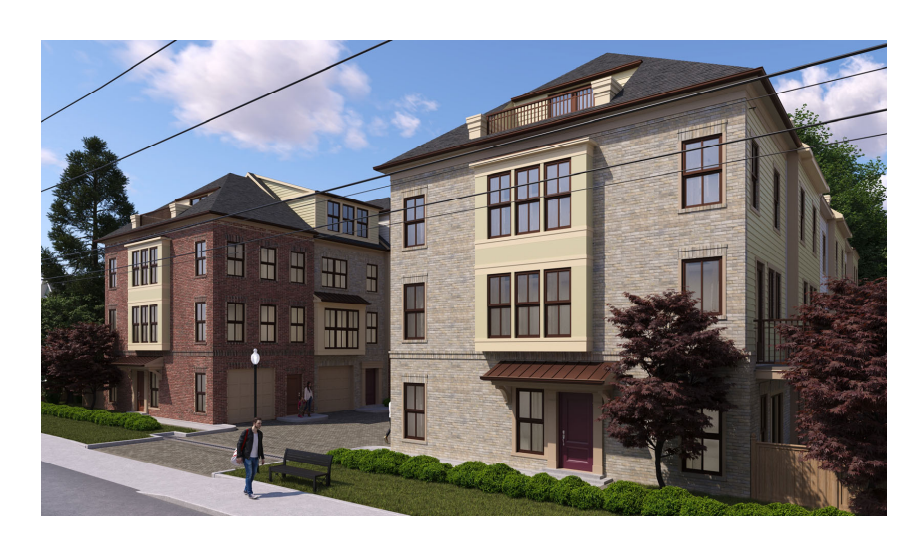
Letty’s Thoughts (bullets 2-5 are from a response I’ve shared with the S. Lee/S. Oak neighbors, so if you’re in that neighborhood, you may have already seen this):
1/ Specific thoughts on this project –
Pros: we do need more middle housing such as townhomes and more homeownership opportunities. Currently, $2M is the new market rate for single family homes and that is the only source of ownership, other than the new condo project at West Falls and the new townhomes underway on Park Ave, enabled by the T zone changes 2 years ago. Townhomes and other middle housing are an important part of our housing stock and meets the need for people downsizing from single family homes, people outgrowing their 2 bedroom apartment or condo – it’s the new starter home. I also think the future zoning designation is appropriate as transition – these are just a few parcels off Broad St, which is a major regional thoroughfare with commercial activity – and townhomes are a good form of transition.
Cons: some of the concerns we’ve heard are valid but can be mitigated (or may be misunderstood – see below!) so the project does need more work. And we’ll also get more data when the townhomes on Park Ave complete in 2025 that I think will help allay some of the community concerns about this proposal.
Current housing stock, from the city’s draft Affordable Living Policy: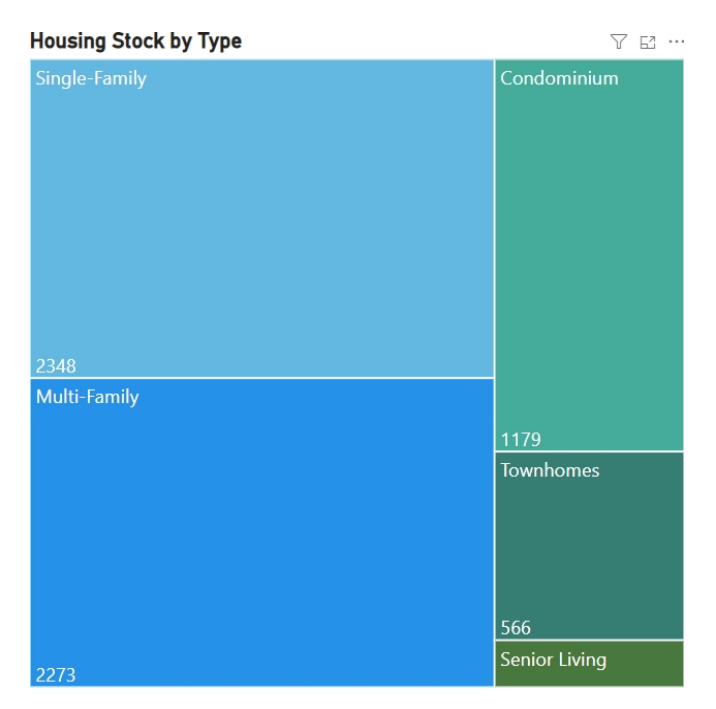
The staff report references the land use chapter of the Comprehensive Plan that talks about the vision for Broad St, which dates from 2005 (20 years ago!) and clearly the city has changed since then. Our planning documents call for “nodes of density” along Broad St with higher density/heights/intensity of uses and then tapering down towards neighborhoods and in between the nodes, with transition zones to enable redevelopment. My personal opinion is that it is important to have a mix of building heights and uses along Broad St. Not every block should have new mixed use building although we should have conditions that enable parcel consolidation, a vibrant pedestrian environment, and new investments in the city whether that’s a new building, a rehab, or adaptive reuse like Godfreys, Northside Social, or Stratford Garden. To me, it creates a more interesting city, avoids creating a canyon effect, and keeps some older spaces that are more affordable to small businesses. It’s worth refreshing that Comp Plan chapter with community input and current market conditions on where redevelopment could/should happen on Broad St and how proposals like the S. Lee townhomes fit into that vision.
2/ Public, transparent process – any re-zonings on S. Lee go through a public process, with lots of opportunity for community discussion and public meetings – a re-zoning is not a by right action. You can see here as an example of this process with the Broad and Washington/Whole Foods project that just opened. This week was our first public discussion. We discuss our schedule weekly with the full City Council in a public meeting that is open to any to attend and also recorded – and we’ve had no public discussion that you’ve missed.
3/ Specific impact assessment – when the process starts, we do evaluate the full spectrum of impacts on the neighborhood and city across the board – especially the areas cited like fiscal, environment, infrastructure, traffic, etc. including referral out to our citizen boards and commissions (again, all public meetings) with specific request to provide feedback in their areas of expertise. All of that weighs heavily in our decision making. The beginning of that assessment is detailed in the staff report we discussed this week. In fact, we use a fiscal impact model for all of large projects to ensure the expected revenue offsets the costs and then go back every few years to see how projects are performing (I last wrote about this report card in 2023). Using the Whole Foods project as an example, here is the meeting from Jan 2021 and all the associated documents that went assessing the project. The staff report does a good job capturing the deliberations and analysis that went into the multi-year process before we gave approval. We also get to negotiate concessions with developers to provide community benefits like affordable housing, monetary contributions, a permanent home for Creative Cauldron, the corner pocket park, streetscape improvements, public parking, etc. I share this project as an example because the S. Lee neighborhood may not be aware of the process.
In contrast, when single family redevelopment happens, which is by-right, we actually have far less control on those impacts beyond what’s allowed by state code (example: we have 35% impervious coverage limit and tree canopy requirements to replace all the trees within 10 years to achieve 20% canopy, but still, many new homes maximize those and they build the biggest possible house which creates neighborhood level flooding and loss of mature trees). Beyond the social impacts of losing older homes, when small older homes are torn down and replaced with much larger new houses – I believe the cumulative fiscal and environmental impacts are actually far greater across the city.
4/ Broad infrastructure planning – schools, stormwater, sewer, traffic, etc. This has been important to me and a large focus since I’ve been on City Council. I’ve long believed that we should be forward thinking and not just reacting to what’s in front of us.
Starting with school capacity – we’ve expanded capacity at all of our schools including the new high school, expansion at Mt Daniel allowing us to move 2nd grade to Mt Daniel and have enough capacity at Oak St Elementary. etc. And we actually keep a close eye on enrollment vs projections annually in collaboration with the School Board and an outside demographer. I believe the latest projections are that we have enough physical capacity in our schools for the next 10 years. It’s a common misconception that we have “skyrocketing” enrollment growth due to development in the city. In fact, I write about this every year so would encourage you to look at that post as that has links to actual enrollment data (we had 3% enrollment growth last year and expect 6% this coming year – all anticipated as new buildings come online. And the reality is that mixed use development’s students represent a very small portion of total school enrollment.)
With stormwater, we actually conducted a city-wide assessment on stormwater issues and capacity in 2019 following the 200 year storm we had that summer. Along with the citizen stormwater task force (I recall representation from S. Lee), that led to prioritization of the “Big 6″ stormwater projects that have been underway since then. New mixed use projects also have to not worsen stormwater runoff and in recent projects, we also negotiate that development improves run off by 20% than pre development conditions. For the T zone townhomes underway on Park Ave, they have to detain water at least to pre development levels and in fact, they’re using on-site bioretention facilities to slow down the immediate discharge of runoff during storm events to meet this requirement. I know adjacent residents at the Broadway have expressed water concerns, but I believe there have been long standing water issues there – one of the public comments we’ve received from a Broadway resident says that there were flooding issues in 2004, long before the townhomes went under construction this year.
As for sewer, every new project pays fees for additional capacity (we don’t have our own sewer system – we send our sewage flows to Arlington or Fairfax) and underway over the past year have been discussions to buy additional capacity from Fairfax with the forecasted growth and/or send more flows to Arlington where we already have excess capacity. Here is the staff report from our work session discussion on forward planning for sewer capacity from May 2024. The staff report explains the issue with peak flows, when there are heavy rain events and stormwater ends up infiltrating into the sewer system (called inflow & infiltration) and there have been staff negotiations with Fairfax County on how to address that. Unfortunately there are inaccurate, incomplete soundbites about sewer when in actuality, I&I is a legacy issue that has worsened with heavier rain events.
Traffic – with every project, we also assess the specific traffic impacts and plan for that accordingly with new infrastructure such as new signals, traffic calming, ped and bike improvements, access to transit, etc. We have multiple projects to improve walkability across the city. While I can’t control car traffic outside of Falls Church as we are at the crossroads of Rt 7, Rt 29, near 66 and the Beltway, you might actually be surprised to know that even with population growth over the past 10 years, traffic volumes actually haven’t increased in the city. Again, I wrote about this in more detail including links to actual VDOT data. I know it doesn’t feel that way the past year when construction has closed off lanes of traffic, but now that we’re past that point with the projects, hopefully things will normalize! As we keep adding more options in the city, hopefully more people including our kids can safely walk or bike around the city, leaving roads and parking spaces to those who truly need to drive and alleviating regional traffic issues.
5/ Upzoning – I think there is a lot of unfounded fear that the city will be upzoning all of R1-A to T Zones or higher. Any re-zoning should conform to the city’s Comprehensive Plan (which again is a very public process with resident engagement) and small area plans. These two sets of plans are the overarching guide to the kinds of development we seek in the city, with nodes of higher density development along our commercial corridors and gentle density tapering into neighborhoods. Specifically, the two parcels identified at the top of S. Lee have long been identified on the city’s “future land use map” as future T zones because they are so close to Broad St. You can see that in the zoning section of the plan, it identifies the first two parcels or so off Broad St as potential rezoning opportunities because medium density would make sense to buffer higher density commercial uses on Broad St from the low density R1-A neighborhoods. The Broad St small area plan was adopted when I was new on City Council in 2016, but I did find my post when I wrote about this before we adopted the small area plan unanimously.
(2) Smart Cities – underway!
I last wrote about Smart Cities in August 2024, when our first traffic signal control box was upgraded as part of the $10M grant to be a living lab for smart cities technology. Since then, more signal boxes have been upgraded, with some data collection already underway. This week we received an update on that work and when we’ll start to see the first round of benefits – starting with new signal timing this fall! (In case you didn’t know – our current signal infrastructure is outdated and is manually timed at each box, so any adjustment at one intersection requires manual intervention at other boxes; mis-timings are common.)
The presentation and the slides below have a lot more details, but the specific use cases will be: new signal timing that will help traffic flow better and alleviate congestion, adaptive lighting, and detecting near miss accidents and smart parking – the latter two I’m particularly excited about given community feedback. I’ve long pushed for more data-driven decision making and improving pedestrian safety and this is a great intersection of the two.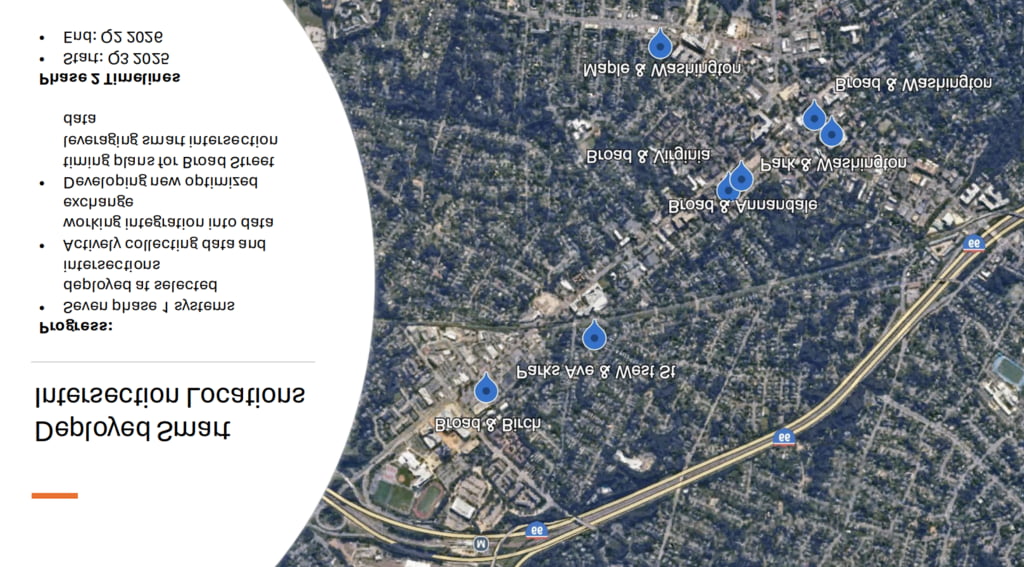
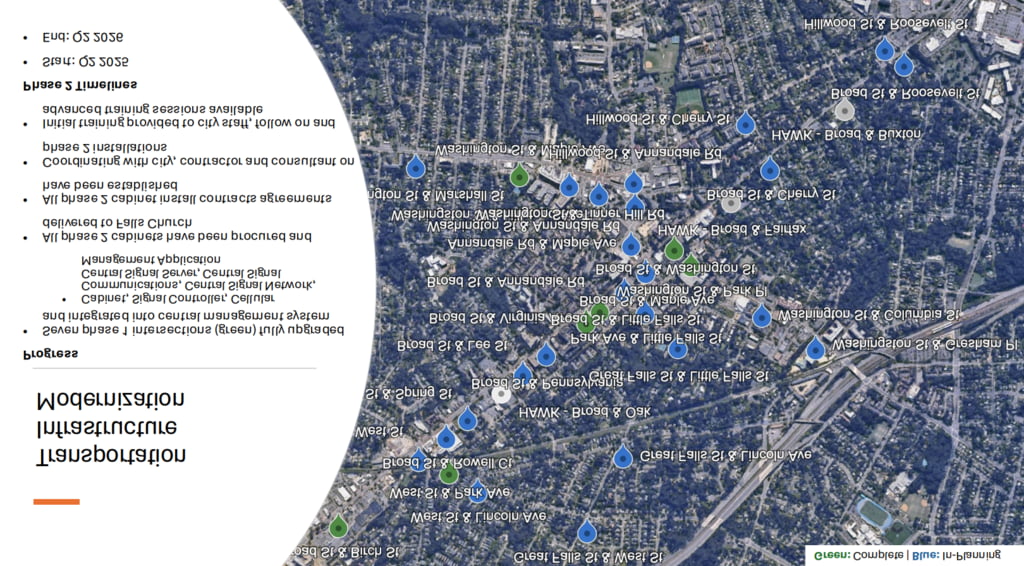
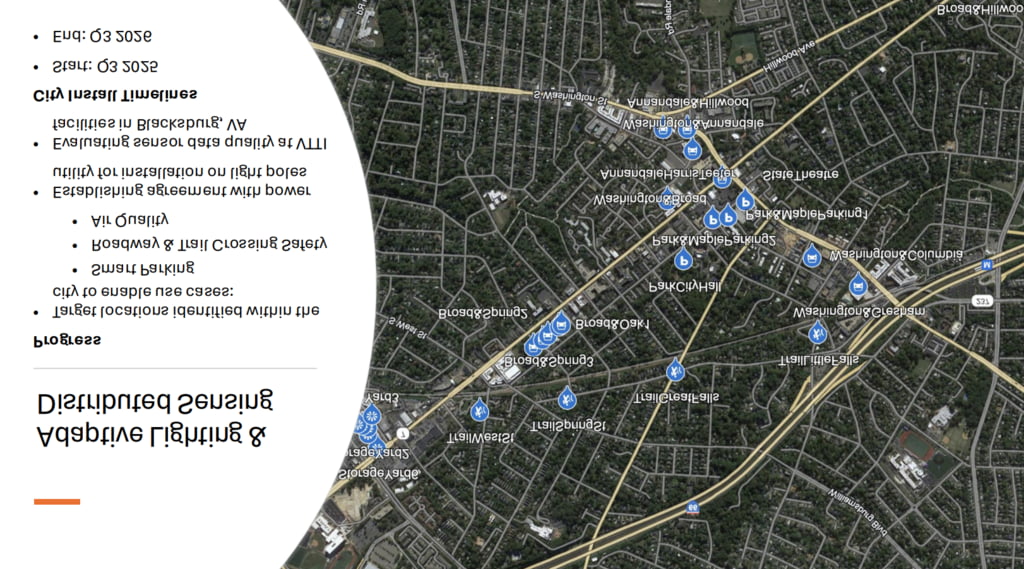
(3) New business / economic development updates
This is always a popular topic so here are the highlights from the EDA’s meeting materials. There are new openings, starting with the soft opening of Paragon Theaters next week and several new restaurants like Little Falls Cafe and Grillmarx opening this summer. Both Founders Row and West Falls have programming and events in their public spaces that you may be interested in checking out. And besides the new buildings, we have smaller projects underway – like the adaptive reuse projects at Stratford Garden and the buildout of Paris Baguette and more restaurants and businesses across the city.
I realize Broad/West is quite messy right now with the work to rectify the stormwater/grading issues with Modera Falls Church (fka Founders Row 2) that were caught during final inspections, so we appreciate everyone’s patience.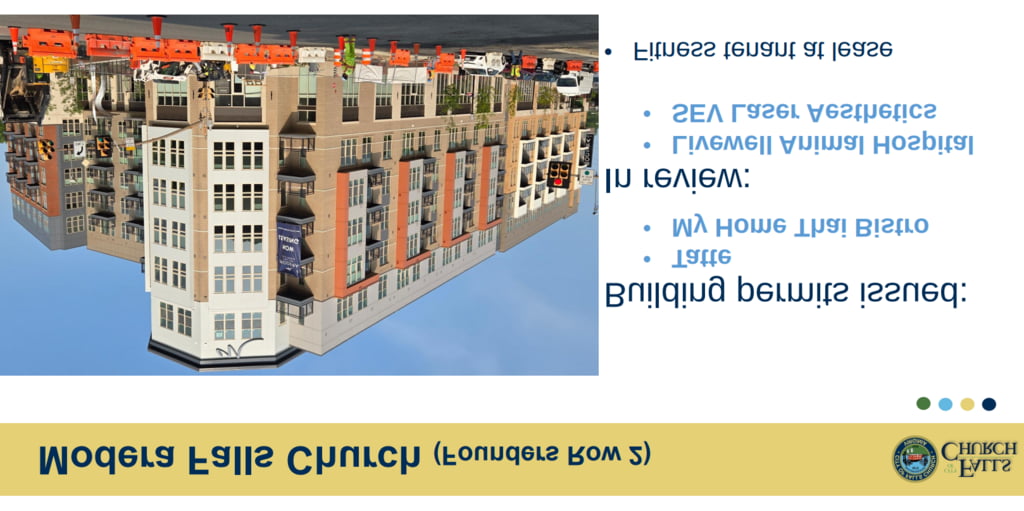
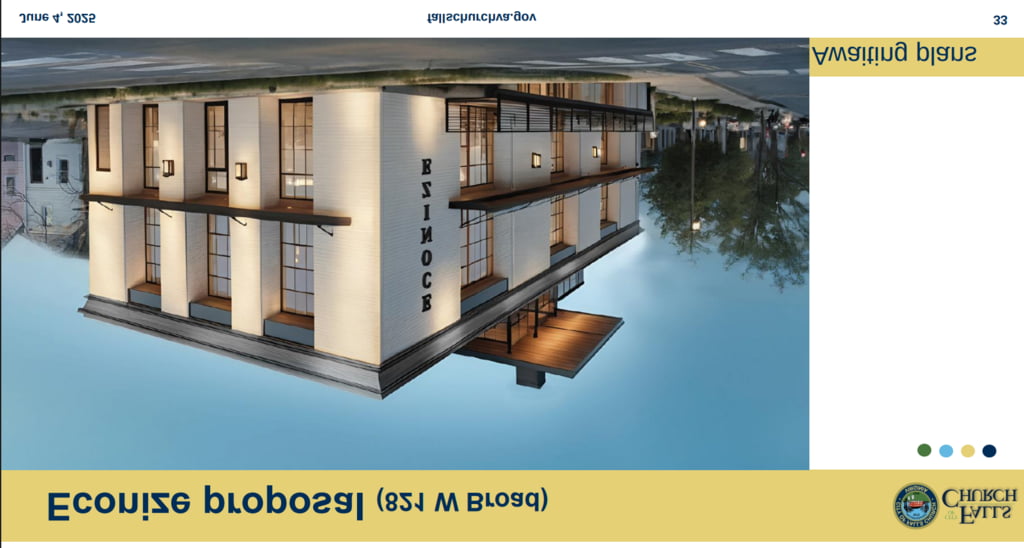
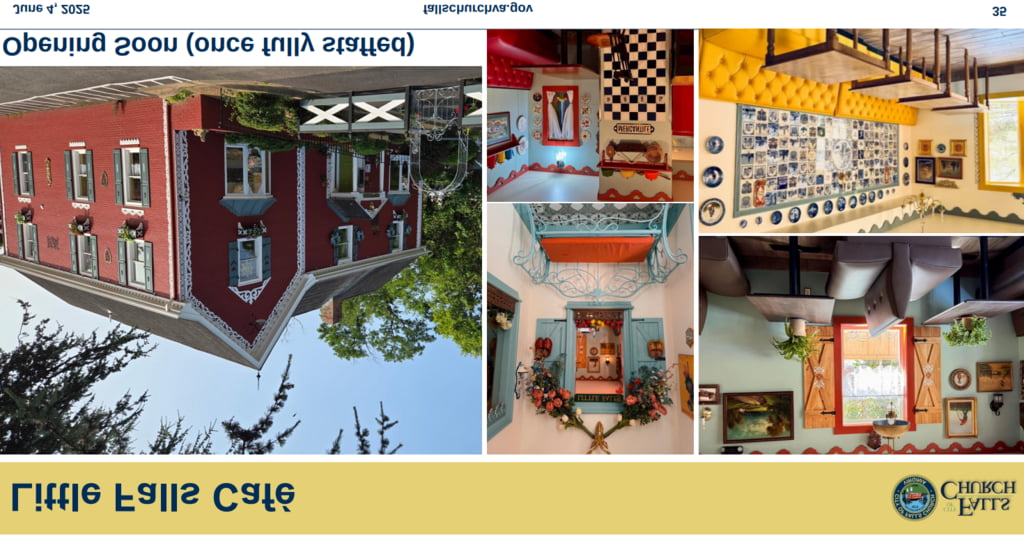
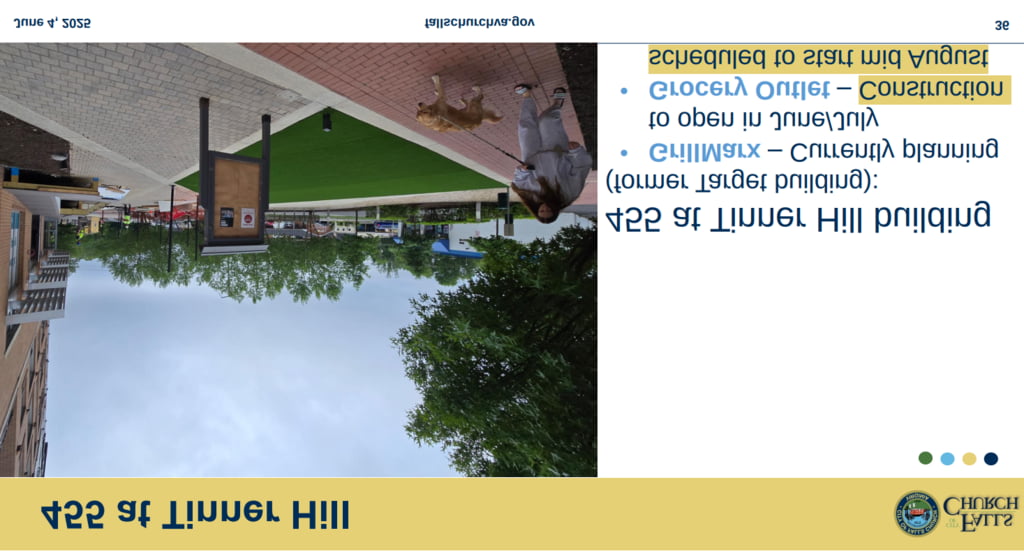
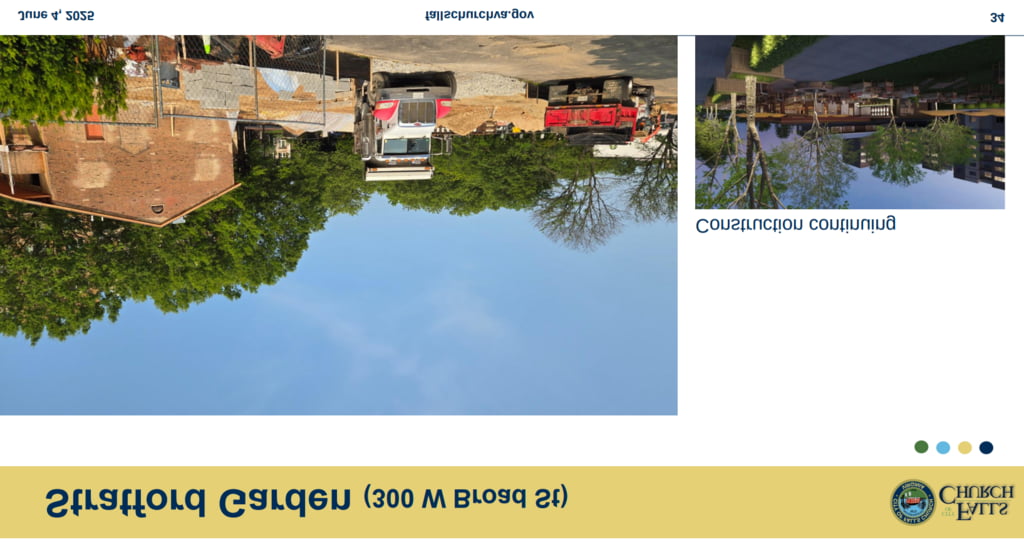
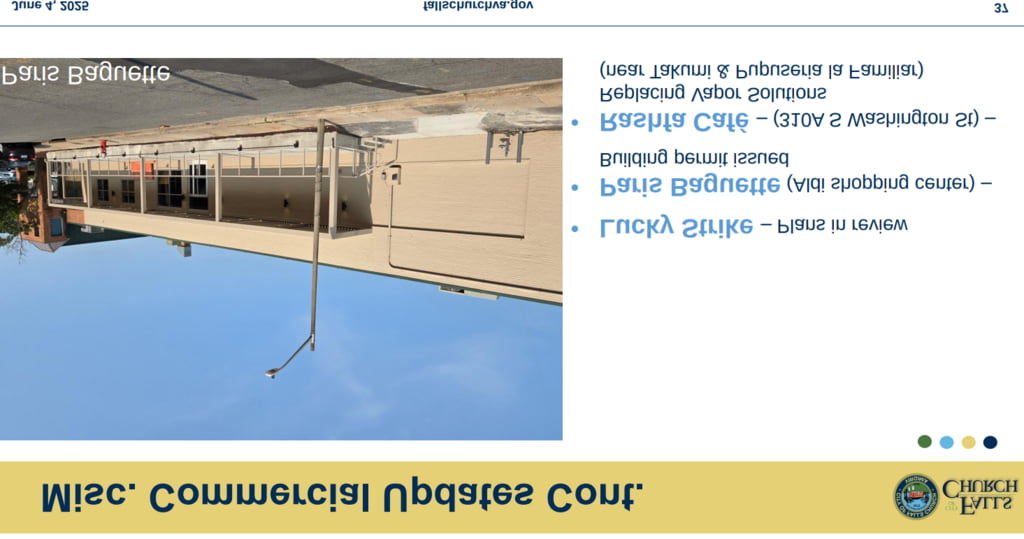


What’s Coming Up:
Monday, June 16 – City Council Meeting*
Wednesday, July 2 – Ask the Council Office Hours (9 am, City Hall)
Monday, July 7 – City Council Work Session*
Monday, July 14 – City Council Meeting*
Monday, August 4 – City Council Work Session*
Wednesday, August 6 – Ask the Council Office Hours (9 am, City Hall)
Monday, August 11 – City Council Meeting*
*Mondays (except 5th Mondays and holidays) at 7:30 pm. You can access the agenda and livestream here, including recordings of past meetings
Letty’s Office Hours:
Monday, June 23 – 12 pm (Mr Brown’s Park)